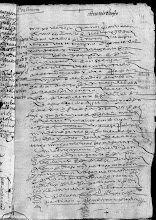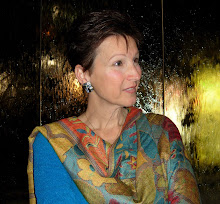 Some people go pub-crawling on their vacations. We went church-crawling. When we were finished, we came back to the hotel and passed out, so I guess we’re not really so different, are we?
Some people go pub-crawling on their vacations. We went church-crawling. When we were finished, we came back to the hotel and passed out, so I guess we’re not really so different, are we?In addition to the huge and famous Gothic cathedral, Köln has twelve historic Romanesque churches (dated 10th to mid-13th century). We went to four of them today, plus another church that was on the way but is too modern to be of much interest to anyone … except us. Don’t worry … I’ll try to make today’s journal entry interesting even though the subject may be a bit staid.
I’ll start with a confession. We overslept this morning and missed breakfast. Instead of 8 o’clock we got up at 10:15 and showered …
Note on the shower. It’s one of those handheld devices. There is liquid soap in a dispenser. One has to stand right under the nozzle which sprays straight down, huddled behind the little glass water deflector which shields only about a third of the tub. In other words, this is not exactly a joyful “yes I’m awake!” morning shower experience. But I digress.
It was a beautiful day … no rain! We ate at a little café, sitting outside in the plaza next to the Cologne cathedral. We had sandwiches and coffee – “Black American coffee?” asked the waiter – and mapped out our route. On the way, we spied an Italian Catholic church called St. Maria Himmelfahrt (it's the pink church shown above).
Note on “fahrt.” It’s a very common German syllable and it means “way.” For example, “Himmelfahrt” means “heaven’s way.” But … another confession … it makes me laugh every time I see it.
The church of St. Maria Himmelfahrt evidently isn’t Romanesque, but we went inside anyway. And isn’t it gorgeous? I think it’s baroque, or perhaps rococo. Anyway, it’s lovely, and so is the image of St. Maria.


Next, we walked (okay, I was hobbling, so Billy carried my purse … thank you, sweetheart). Bill comments: The "purse" was more like a suitcase, filled with books you bought in every church and information shop. The Dominican church of St. Andreas (aka St. Andrew) dates from the early 10th century; it’s beautiful, has a very cool statue of Andrew clothed in armor, and has a crypt with a dead saint, Albertus Magnus, entombed within.




Note on Albertus Mangus. He was Bishop of Regensburg from 1260 to 1262 – I’m thinking about you, Dr. Sheffler!
My favorite part of the church of St. Andreas was the unusual Pieta, which I found very moving. This is a painted wooden statue carved in the early 1300s. It is said that Mary’s facial expression is either tearful or a “transfigured smile, depending on the point of view of the observer.” I saw her as crying, and her demeanor so sorrowful that it made me weep too. Can anyone possibly see a “transfigured smile?” Click on the photo to make it bigger.

My favorite part of the church of St. Andreas was the unusual Pieta, which I found very moving. This is a painted wooden statue carved in the early 1300s. It is said that Mary’s facial expression is either tearful or a “transfigured smile, depending on the point of view of the observer.” I saw her as crying, and her demeanor so sorrowful that it made me weep too. Can anyone possibly see a “transfigured smile?” Click on the photo to make it bigger.

After St. Andreas, we walked to the churches of St. Gereon, St. Maria im Kapitol and Gross St. Martin. Don’t stop reading … I’ll just hit the highlights!
St. Gereon is beautiful inside.

St. Gereon is beautiful inside.

The original Christian church was built on this site in the 4th century by Helena, the mother of Constantine the Great (who legitimized Christianity within the Roman Empire). Gregory, Bishop of Tours mentioned the church in his 6th century history. Alterations to the church were done from the 11th century to the present day; the church was very badly damaged during WWII, as were most of the Romanesque churches in Cologne. It also has big, unidentified bones hanging on the wall over an old confessional ... and no one to ask what they are. Mammoth bones?


St. Maria im Kapitol is really fascinating: it was the first clover-leaf designed church choir in the Western world. Also, the original Christian church on this site was part of the Benedictine convent built by St. Plectrudis, who was the widow of Pippin, and the step-mother of Charles Martel … which means she was the step-great grandmother of Charlemagne. Very interesting! It seems it was not just the hot sulphur springs which drew Charlemagne to Cologne. At any rate, it became a “noble institution for ladies of rank in the 12th century,” and Plectrudis is entombed there. I'd post the picture of her crypt, but I think I've exceeded my limit because when I hit "add image," Blogger just blinks at me and groans.

Note on the priests. They have no sense of humor and they are immune to my charm.
We’re back in our room now, where I’m just about to repack my suitcases before our train trip to Paris tomorrow.

Gross St. Martin has been almost completely rebuilt due to war damage; in fact, they’re still working on it. But the crypt is cool … it has Roman foundations which are currently being excavated. I asked the French priest to show me where there was a statue or painting of St. Martin, but he indicated there was none.
The church of Gross St. Martin is right on the Rhine River, looming over cobblestone streets with restaurants and cafes, so we climbed down the stairs and sat at a table outside in the sun. I had lasagna and Bill had a German dish with spargle (asparagus which has been covered with dirt while it grows so it is white when harvested). On our way back to the hotel, we stopped for a last look at the Cologne Cathedral. I know they were closing, but I really wanted to see the Milanese Madonna.
The church of Gross St. Martin is right on the Rhine River, looming over cobblestone streets with restaurants and cafes, so we climbed down the stairs and sat at a table outside in the sun. I had lasagna and Bill had a German dish with spargle (asparagus which has been covered with dirt while it grows so it is white when harvested). On our way back to the hotel, we stopped for a last look at the Cologne Cathedral. I know they were closing, but I really wanted to see the Milanese Madonna.
Note on the priests. They have no sense of humor and they are immune to my charm.
We’re back in our room now, where I’m just about to repack my suitcases before our train trip to Paris tomorrow.


4 comments:
St.Gereon looks gorgeous. Weird about the bones. Is that a tusk? Or a rib bone.
I looked at Mary and I saw a Mona Lisa smile. *shrug*
My fave pic, though, is the one of the door. I don't know why, but I have this odd fascination with the wrought iron scroll work on these old doors. I first saw it on the door of Bolton Priory and was captivated. Not so much because it's exquisite art or anything, but just imagining the time and hard work necessary to accomplish the design makes me gobsmacked.
Have a safe trip to Paris.
Your trip sounds like fun and a busy sightseeing schedule. All very interesting and informative. I do remember Aachen when I was over there. If you can believe, I hosted the German Rotary District 1950 on Wednesday. I was telling about you and Bill. We had a toast together. I did a special tasting of 5 flights of German wine grown at LaRue. They were impressed. One member wants to do a pairing of my wines with German wines. I ship mine to him & in return he ships the German wines to me. That will be an interesting tasting! How bout that. Cheers and have fun, Don
Karen,
Absolutely fascinating!
I tried searching on Google for an explanation of the bones. No dice. Ah, well.
Glad to find a fellow church hopper! I just love visiting religious sites, too. I don't think there's anything more revealing about a culture than how they display their faith. Thanks for the photos and the descriptions.
Post a Comment